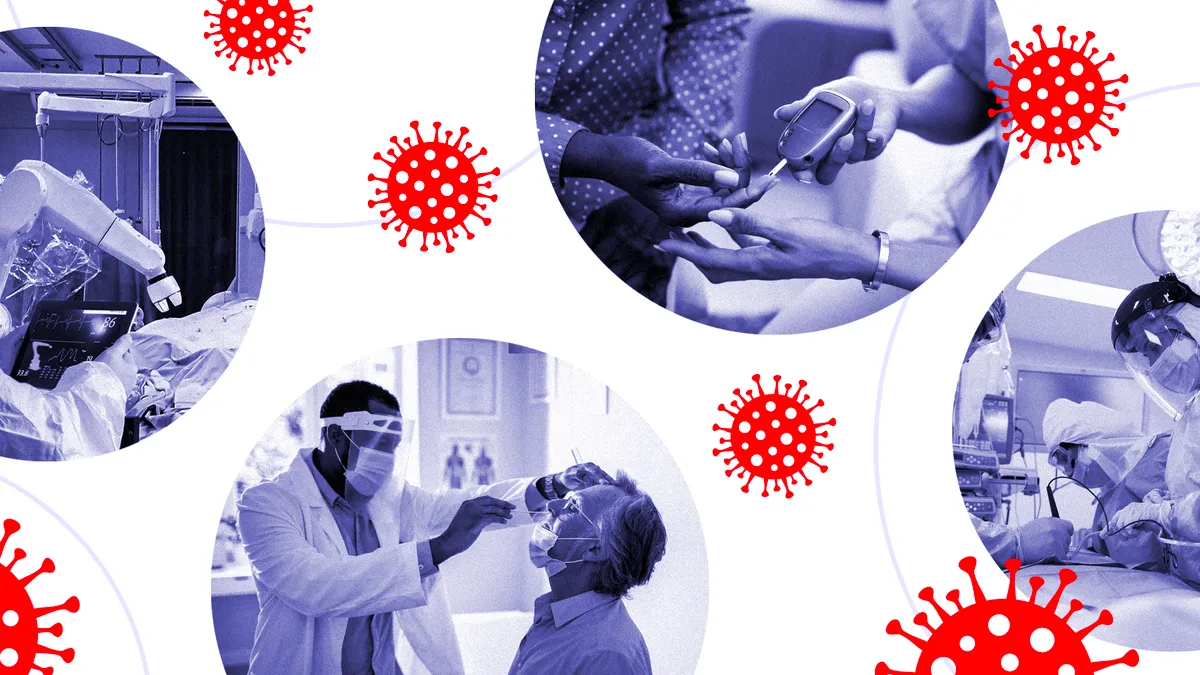This story is part of a MedTech Dive series examining the impact of the COVID-19 pandemic on the medtech industry, published one year after the start of the crisis. You can find the other stories here.
When hospitals and other facilities abruptly halted elective care roughly a year ago to help mitigate the impact of the intensifying coronavirus pandemic, the economic effects rippled across the healthcare industry.
Hospitals lost billions of dollars as the lucrative procedures faded away. Smaller providers like dentist and physician offices also took large financial hits. And top medtechs, many of which are reliant on elective care to drive revenue growth, saw businesses fall.
The effects were also felt by patients. Some procedures delayed or canceled were not just aesthetic surgeries but considered essential care, such as joint replacements to reduce pain or cardiac procedures that can be lifesaving.
While procedure volumes returned throughout 2020 from the lows of March and April, they fell once again in November and December, and top medtech executives warned unexpected slowdowns in the fourth quarter would likely spill into 2021.
After the worse-than-expected last four months, things have recently looked up.
Mayuri Shah, a partner with Bain & Company, said vaccine rollouts have been faster than expected and some regions are opening up at a faster pace than others, all contributing to an uptick in elective procedures.
"The first few weeks [of 2021], were surprising in a negative way. Things were hit much more than folks anticipated," Shah said. "It's also, in the same way, picked back up more quickly than anticipated."
As industry and experts look further into 2021, all eyes are on both when and how elective care comes back.
Rebound varying by procedures
As medtech companies reported earnings throughout last year, it became clear that the pandemic had a varied impact.
Abbott Laboratories and Becton Dickinson scrambled to develop COVID-19 tests or testing platforms, both of which ultimately offset losses from traditional business lines. Companies in virtual care like remote patient monitoring or wearables — especially diabetes players like Dexcom and Insulet — saw business take off as patients stayed home.
However, companies like Stryker or Boston Scientific struggled as they are more dependent on procedures. Stryker said that procedure deferrals impacted about 40-50% of its business.
Non-emergent procedures, particularly in orthopaedics, were slammed as hospitals reserved resources for COVID-19 surges and emergencies.
Orthopaedic sales dropped in 2020 compared to 2019
| Company | Hip Segment |
Knee Segment |
Total Orthopaedics |
| Johnson & Johnson | -11% | -21% | -12.2% |
| Stryker | -12.8% | -13.7% | -5.6% |
| Zimmer Biomet | -9.4% | -15% | N/A |
| Smith & Nephew* | -7.5% | -21.1% | -13.7% |
SOURCE: Data from companies' earnings reports
*Smith & Nephew's figures are for reported revenue
Cardiac procedures also dropped last year despite the more emergent nature of the surgeries. A study from the Society of Thoracic Surgeons found adult cardiac surgery volume in the U.S. fell 53% compared to 2019, with elective cases dropping by 65% and non-elective cases down 40%. The study examined data from January to June 2020.
Bain's Shah said that an electives rebound this year is likely to mirror what occurred in 2020 — emergent procedures like cardiac surgery and cancer oncology will return more quickly.
While orthopaedic procedures are not considered to be highly emergent, the category may have a quicker recovery because they are more profitable for hospitals, according to Shah.
This trend was seen in 2020. Full-year results for orthopaedics declined; however, hip and knee segments for Stryker and Zimmer nearly climbed back to pre-pandemic levels by the end of the third quarter before the fourth quarter slump.
Despite some optimism, questions still linger about what exactly a recovery will look like.
Medtechs have largely predicted a second-half recovery as vaccines become more widespread and COVID-19 cases drop. However, executives have avoided giving specific timelines due to uncertainty of the pandemic, especially with new variants.
And while Wall Street mostly agreed on a similar timeframe in 2021 outlooks, SVB Leerink analyst Danielle Antalffy said that a recovery for the medtech industry could come sooner if vaccine rollouts broaden and COVID-19 cases keep falling.
"If things continue as they are, I do think a summer start to a recovery is very feasible, and I would think ... Q3 [or] maybe even sooner, honestly," Antalffy said.
Growth above pre-pandemic levels, which will remain the measuring stick for determining companies' 2021 success, could be achieved by the end of the year for a good portion of the industry, Antalffy predicts.
Looking beyond backlogs
One bright spot for an electives comeback is a potential backlog for companies to work through when hospitals ramp up surgery volumes, as they inevitably will.
Zimmer Biomet CEO Bryan Hanson said during a recent analyst event that hundreds of millions of dollars of procedures have built up, and the company expects to work through most of that amount.
About 65% of postponed procedures were ultimately done in 2020, which was lower than expected due to the surge at the end of the year, according to a survey of 47 hospital administrators from SVB Leerink.
The analysts wrote the decline could actually help medtechs this year as companies "may see stronger 2021 procedure volume trends than previously contemplated, as there is likely to be more backlog to work down across the board."
Respondents expect to ultimately reschedule about 99% of delayed procedures across all procedure lines.
Shah questioned how quickly new procedures can be filled once backlogs are worked through. Total patient visits at hospitals are still below pre-pandemic levels, which could present a challenge for getting new patients once backlogs are gone.
Although, Shah agreed that hospitals will work through suspended or delayed procedures rather quickly.
How much of a backlog exists is not the same for every medtech subsector.
Orthopaedic companies have a much clearer idea of where backlogs currently stand as procedures were largely halted, according to Antalffy. However, for cardiac companies like Edwards Lifesciences, there's uncertainty about how many procedures there are to recapture as surgeries have been performed throughout the pandemic.
There may also be a capacity issue slowing the number of procedures able to be conducted as multiple specialists, nurses and an overnight stay in a hospital are required for a procedure like transcatheter aortic valve replacements, Antalffy said.
On the hospital side, Rick Gundling, senior vice president of healthcare financial practices for the Healthcare Financial Management Association, said patient comfort level will be key. If patients do not feel confident returning to hospitals, that could strain growing procedure volumes beyond backlogs.
"[Hospitals] still feel there's a portion of people that are just staying away, they're not getting the treatment at all and will put it off as long as they can," Gundling said.
New infection protocols like limiting waiting room numbers or having longer times between scheduled visits could also weigh on volumes once hospital and healthcare facility operations normalize, he added
Challenges remain
The shutdown in elective care did not just bring procedures to a halt, some migrated to outpatient settings or ambulatory surgery centers, accelerating a recent trend occurring over the last several years.
Medtechs have focused more closely on ASCs as procedures like knee and hip replacements have moved out of hospitals and CMS expanded Medicare coverage to outpatient clinics. Due to restrictions put in place by hospitals over the last year, the alternative settings have been an option for patients.
For the procedures that have moved to ASCs, both analysts Antalffy and Shah do not expect a meaningful shift back to hospitals.
Even with a rebound expected in the coming months, challenges are still ahead for medtechs. Shah pointed to potential threats like the regional hotspots with COVID-19, a rise of virus variants and potential struggles to refill patient pipelines.
"I think, yes, there is a very positive story we could believe in," Shah said. "But it's so dependent on case counts, on patient visits, on vaccines, on local regulations, that any one of those could really change the story."
One point magnified by the pandemic is just how reliant the medtech industry is on elective care. However, both Antalffy and Shah were not sure if there will be any longer-term structural changes to the industry.
"At the end of the day, these are all still going to be very procedure-heavy companies," Antalffy said.


















